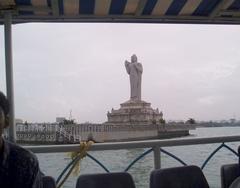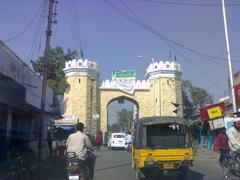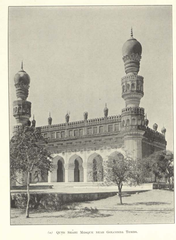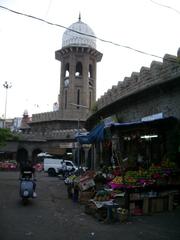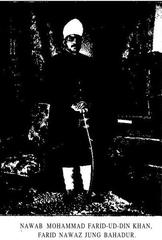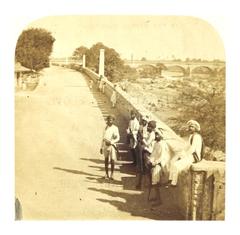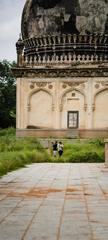Sri Kashi Bugga Mandir: Visiting Hours, Tickets, and Guide to Hyderabad’s Historic Temples
Date: 14/06/2025
Introduction
Sri Kashi Bugga Mandir stands as one of Hyderabad’s most revered Hindu temples, celebrated for its mystical perennial water spring, unique Swayambhu Shiva Lingam, and deep-rooted connection to the spiritual sanctity of Varanasi’s Kashi Vishwanath Temple. Nestled in the Kishan Bagh area near the Musi River, this temple is not only a place of worship but also a vibrant center of cultural heritage, attracting both devotees and history enthusiasts. The temple’s enduring legacy is shaped by centuries of religious devotion, community involvement, and architectural brilliance, reflecting Hyderabad’s pluralistic ethos and rich history (Telangana Tourism, The Hans India, Cultural Heritage of Hyderabad).
Table of Contents
- Origins and Historical Foundation
- Architectural Features and Symbolism
- Religious Significance and Rituals
- Visitor Information: Hours, Tickets, Accessibility
- Travel Tips and Nearby Attractions
- Special Events, Festivals, and Guided Tours
- Cultural and Community Importance
- Preservation Efforts and Modern Amenities
- Frequently Asked Questions (FAQ)
- Conclusion and Final Tips
- References
1. Origins and Historical Foundation
Sri Kashi Bugga Mandir’s name blends “Kashi” (Varanasi) and “Bugga” (spring in Telugu), signifying its aspiration to mirror Varanasi’s sanctity and its unique perpetual water source. Oral traditions and historical accounts suggest the temple was established between the late 16th and early 19th centuries, with strong ties to Hyderabad’s aristocracy and spiritual patrons. Raja Raghu Ramji is credited with its foundation in 1822 CE, and the temple has since seen stewardship by dedicated trustees, including the current trustee Nanda Kumar (The Hans India).
The temple’s Stala Purana tells of a divine spring emerging near the Shiva Lingam, believed to embody the Ganges’ purity and power. This rare feature has elevated the temple’s spiritual significance, making it a vital pilgrimage site for those unable to travel to Varanasi.
2. Architectural Features and Symbolism
Sri Kashi Bugga Mandir exemplifies a harmonious blend of Dravidian and Deccan architectural styles. Its modest yet ornate gopuram (gateway tower) features intricate stucco work and mythological motifs. The temple’s spatial organization includes:
- Sanctum Sanctorum (Garbhagriha): Houses the Swayambhu Shiva Lingam, with a continuous flow of sacred water from an underground spring.
- Mandapa (Pillared Hall): Used for collective prayers and rituals, adorned with carved pillars and painted panels depicting Shiva’s legends.
- Circumambulatory Path: Allows devotees to perform pradakshina (ritual circumambulation).
- Shrines: Dedicated to Parvati, Nandi, Ganapati, Kartikeya, and the Navagrahas.
Construction materials like locally sourced granite and lime mortar ensure durability. The shikhara atop the sanctum is decorated with kalashas and floral motifs, symbolizing fertility and divine abundance (Cultural Heritage of Hyderabad). The temple’s unique water spring is a powerful symbol of purity, liberation (moksha), and continuous divine grace.
3. Religious Significance and Rituals
Devotees revere Sri Kashi Bugga Mandir as a spiritual alternative to Kashi Vishwanath, believing prayers here are as meritorious as those offered in Varanasi (MakeMyTrip). The temple’s most distinctive feature is the Swayambhu Shiva Lingam, continuously bathed by sacred water—“Kashi water”—believed to fulfill wishes and possess healing properties (Heart of Hyderabad Blog).
Major Rituals:
- Abhishekam: Ritual bathing of the Lingam, especially auspicious on Mondays.
- Archana: Personalized prayers for devotees.
- Annadanam: Free meal offerings on special occasions.
- Festivals: Maha Shivaratri is celebrated with night-long prayers, special abhishekams, and vibrant cultural events. Kartik Purnima and Shravan Mondays also attract large gatherings (The Hans India).
Legend tells of snakes performing Abhishekam at dawn, adding to the temple’s mystical reputation (Haarati.com).
4. Visitor Information: Hours, Tickets, Accessibility
Timings:
- Morning: 6:00 AM – 12:00 PM
- Evening: 5:00 PM – 8:00 PM
- Extended hours during festivals (sometimes up to 9:00 PM).
Entry:
- Free for all visitors.
- Special poojas or abhishekam may involve a nominal fee (e.g., ₹576).
Accessibility:
- Wheelchair ramps and smooth pathways are available.
- The underground sanctum requires descending steps, which may be challenging for those with mobility issues.
Facilities:
- Drinking water, restrooms, shaded seating, and shoe racks.
- Limited parking; public transport is recommended during peak periods.
Etiquette:
- Modest dress, footwear removal, and maintaining silence are encouraged.
- Photography is allowed in the outer courtyards but restricted in the sanctum.
5. Travel Tips and Nearby Attractions
Getting There:
- Located in Kishan Bagh near Musi River, about 5 km from Charminar.
- Accessible via auto-rickshaw, taxi, local buses; Hyderabad Deccan (Nampally) station is 10 km away; airport 20 km away.
Nearby Attractions:
- Charminar
- Chowmahalla Palace
- Mecca Masjid
- Murali Manohar Swami Mandir
- Musi River banks for scenic reflection and photography (BestBus.in)
Best Time to Visit:
- Early morning for tranquility and unique rituals.
- Mondays and Maha Shivaratri for vibrant festival experiences.
- Weekdays for a peaceful atmosphere.
6. Special Events, Festivals, and Guided Tours
Maha Shivaratri:
The temple is illuminated with oil lamps, adorned with flowers, and filled with devotional music and cultural performances, drawing thousands of devotees (Hyderabad Mail).
Guided Tours:
Available by prior request through the temple office, especially during major festivals. These tours provide insights into the temple’s history, architecture, and rituals.
Community Engagement:
Annadanam (free meals), charitable activities, and cultural programs reinforce the temple’s role as a spiritual and social hub.
7. Cultural and Community Importance
Sri Kashi Bugga Mandir is a living testament to Hyderabad’s diverse religious landscape. It has thrived under the patronage of the Qutb Shahi and Nizam dynasties, both of whom fostered religious tolerance and cultural synthesis (Cultural Heritage of Hyderabad). The temple’s revival after years of neglect—spearheaded by community efforts and local trustees—underscores the resilience of faith and heritage in urban India (The Hans India).
Located in a multicultural environment, the temple promotes interfaith understanding and serves as a bridge between communities, embodying Hyderabad’s pluralistic spirit.
8. Preservation Efforts and Modern Amenities
Conservation:
The temple’s architectural integrity is maintained through community-led initiatives, periodic renovations, and support from heritage organizations. Recent upgrades include electric lighting, digital information displays, crowd-control railings, and CCTV cameras.
Modern Amenities:
- Clean drinking water
- Restrooms
- Seating areas
- Digital displays for ritual timings and temple history
- Environmentally conscious waste management
- Accessibility features for differently-abled visitors
9. Frequently Asked Questions (FAQ)
Q: What are the temple’s opening hours?
A: 6:00 AM–12:00 PM and 5:00 PM–8:00 PM daily; extended hours during festivals.
Q: Is there an entry fee?
A: No, entry is free. Special poojas/rituals may have separate fees.
Q: Are guided tours available?
A: Yes, upon request with the temple office, especially during festival periods.
Q: Is the temple wheelchair accessible?
A: Yes, but the sanctum requires steps; assistance is advised.
Q: Can I take photographs?
A: Permitted in outer courtyards; restricted in the sanctum.
Q: What are the best nearby attractions?
A: Charminar, Chowmahalla Palace, Mecca Masjid, and the scenic Musi River.
Q: What is the best time to visit?
A: Early mornings for peace; Maha Shivaratri and Mondays for festivals.
10. Conclusion and Final Tips
Sri Kashi Bugga Mandir offers an unparalleled blend of spiritual depth, historical richness, and cultural vibrancy. Its unique Swayambhu Shiva Lingam, perpetual holy spring, and devotion-filled rituals make it a must-visit for anyone seeking to explore Hyderabad’s religious and architectural heritage. Visitors are encouraged to attend during festivals like Maha Shivaratri for a full immersion in the temple’s traditions. For a seamless experience, download the Audiala app for guided tours and up-to-date information, and respect local customs to honor the sanctity of this treasured site.
11. References
- Telangana Tourism
- The Hans India
- Cultural Heritage of Hyderabad
- Hyderabad Mail
- BestBus.in
- Heart of Hyderabad Blog
- MakeMyTrip
- Haarati.com
- NewsMeter
